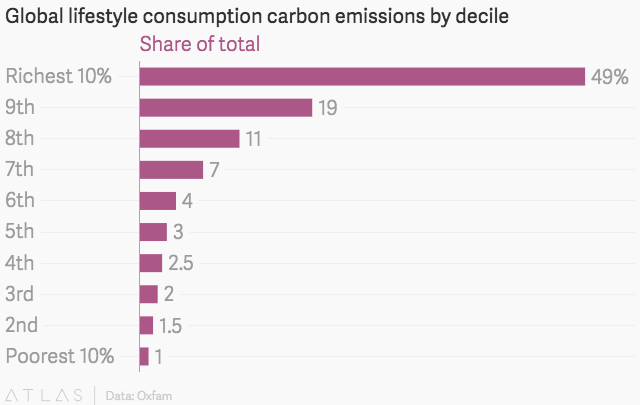-
Tips for becoming a good boxer - November 6, 2020
-
7 expert tips for making your hens night a memorable one - November 6, 2020
-
5 reasons to host your Christmas party on a cruise boat - November 6, 2020
-
What to do when you’re charged with a crime - November 6, 2020
-
Should you get one or multiple dogs? Here’s all you need to know - November 3, 2020
-
A Guide: How to Build Your Very Own Magic Mirror - February 14, 2019
-
Our Top Inspirational Baseball Stars - November 24, 2018
-
Five Tech Tools That Will Help You Turn Your Blog into a Business - November 24, 2018
-
How to Indulge on Vacation without Expanding Your Waist - November 9, 2018
-
5 Strategies for Businesses to Appeal to Today’s Increasingly Mobile-Crazed Customers - November 9, 2018
Rich lifestyles are imposing carbon emissions on poorest
The lifestyle choices of the richest tenth of the population mean they have on average 11 times higher carbon footprint than the poorest half of the world’s population, the report by Oxfam said. Ironically, the 10% richest will be the least affected by the consequences of climate change, while the 3.5 billion poorest will be the most threatened.
Advertisement
Most of the world’s richest 10% high emitters still live in wealthy OECD countries, although that is slowly changing. “The rebuttal is now most of the rising emissions are now coming out of the developing world”.
“We are seeing huge wealth growth in the developing world in China, India and Brazil”, said Hoffman.
The emissions of someone in the poorest half of the Indian population are on average just one-twentieth those of someone in the poorest half of the USA population. Rich countries say that everyone has a responsibility to cut emissions in order for future targets to be met. Also, someone in the richest 10 percent of India’s citizens uses on average just one quarter of the carbon of someone in the poorest half of the population of the U.S.
The report also points out that while poorer developing countries now have the fasting growing rate of emissions, most of the production fuels consumption in richer countries, underlying the global inequalities behind climate change.
The report shows that the richest 10 percent of the USA, about 30 million people, produces three times as many emissions as the 600 million people that constitute China’s poorest half; while the poorest half of the US produces five times the amount of emissions as the poorest half of India.
When it comes to human-caused climate change, pointing fingers to say who’s accountable for what has been an understandably controversial issue, and the AFP mentions that the world’s richest and poorest countries remain “deeply divided” on how to divvy up the responsibility for curbing carbon emissions.
Fossils fuels are fuels formed by natural processes, such as the decomposition of buried dead organisms over hundreds of millions of years.
Tackling the economic inequality that these carbon barons’ thrive on is critical both to ending extreme poverty and fighting climate change.
“Governments in Paris need to stand up to their influence, and stand up for their citizens – the poorest, lowest emitting and most vulnerable among them first and foremost – if Paris is to deliver an agreement for those who need it most”, said the study that was released on Wednesday.
“Increasingly members of the richest 10% are experiencing the impacts of climate change themselves, and are mobilizing to demand action from their governments”, it notes.
Advertisement
“Extreme carbon inequality has to be capped”. “Any deal must keep alive the possibility of holding global warming at 1.5 degrees Celsius, and provide a major boost in funding to help the poorest and most vulnerable communities adapt to climate change”.




























